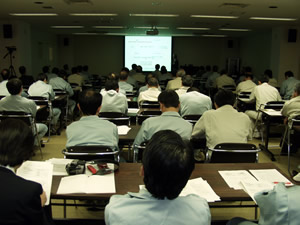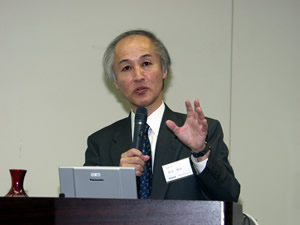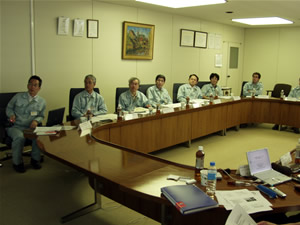|
|
 |
|
|
The 92nd Safety Caravan was conducted at Mitsubishi Nuclear Fuel Co., Ltd. in Tokai-mura, Naka-gun, Ibaraki Prefecture on March 1, 2007. (The Safety Presentation was co-sponsored by Nuclear Development Corporation.) |
| Safety Presentation |

|
|
During the Safety Presentation
|
Approximately 40 employees of Mitsubishi Nuclear Fuel Co., Ltd. attended the Safety Presentation.
The presentation began with a salutation from Mr. Hideo Hariyama, Representative Director and Vice President of Mitsubishi Nuclear Fuel Co., Ltd. "First of all I would like to thank Professor Sugiman from Kyoto University, Mr. Miyamoto from Shikoku Electric, and participants from JANTI for taking time off from your busy schedule today in order to attend this Safety Caravan. On behalf of Nuclear Development Corporation as well as Mitsubishi Nuclear Fuel Co., Ltd., we express our sincere gratitude. We in the nuclear power business have engaged in all sorts of activities aiming at zero calamities and zero problems. When such phenomena do occur, however, we all put our heads together to find the causes, conduct peer reviews, and devise ways of preventing recurrence of similar events. However, when we consider whether we have evolved as a group or as an organization, there are woeful doubts, and we must always think about the best course of action on a day-to-day basis. In regard to endeavors in safety campaigns, security activities, and to human error, I am confident that we are moving forward in each individual activity, but when we consider whether progress is being made toward becoming a firmly grounded organization or whether anything is being learned from these lessons, we have much to anticipate from Professor Sugiman's lecture today on the 'Learning Organization.' I am looking forward to it. Also, this afternoon we will hear about endeavors being made by Shikoku Electric and examples of good practices, which I believe will provide useful references to us all. Well, then, without further ado, let us begin."
After this opening remarks, Mr. Naruse, one of JANTI's directors, presented an overview of this organization's activities, followed by Dr. Academics Toshio Sugiman, Professor of the Graduate School of Human and Environmental Studies, Kyoto University who will lecture on "Fomenting a Safety Culture Through a 'Learning Organization'." |
Lecture highlights |

|
Dr. Toshio Sugiman, Professor of the
Graduate School of Human and
Environmental Studies,
Kyoto University
|
In addition to the concept of a "managing organization," the concept of "the learning organization" is also being sought. The concept of fomenting a safety culture in the nuclear power organization is also being sought. Conventionally, could it be said that both on the organization's side and on the regulatory side, although there has been the concept of the "managing organization," that of the "learning organization" has been scant.
A "learning organization" does not mean an organization whose members do a lot of studying. In any workplace, in any organization, there are always going to be a great number of "self-evident prerequisites" (unspoken rules). That is what makes it possible for the workplace or organization's activities to proceed smoothly. At the same time, however, these self-evident prerequisites tend to restrict the actions and decision making ability of the organization or workplace. And especially when confronted by a new problem for which there is no precedent, or when there is a call for some new activity which has never existed up until now, we may find our hands and feet bound by self-evident prerequisites.
As for these self-evident prerequisites, because they are so plainly obvious, they do not even enter into the conscious mind, nor are they ever verbally expressed. In other words, it is difficult to become aware of the self-evident prerequisites that are based within ourselves. We follow these rules to the letter even without being aware of them -- those are what we can call self-evident prerequisites.
A "learning organization" is one where everyone communicates in a way conducive to becoming aware of these self-imposed self-evident prerequisites and where everyone communicates in a way conducive to breaking free from the bonds of self-evident prerequisites. The book written by Peter M. Senge that raises the theory of the "learning organization" is one of the literary works that has had the most profound impact on the Academy of Management in the US over the past ten years.
In this era of major changes, and the era of not-yet-known experiences of globalization, we need to become aware of the conventional self-evident prerequisites and reshape them so as not to be shackled by such self-evident prerequisites. Also, the urge to resist top-down type organizational management is becoming stronger, particularly among the younger generation. What is called for is a learning organization where that urge to resist is diminished and one that produces a forward-looking vector, in other words, an organization that is capable of refreshing experiences where ideas can meet head on, where one can say, "Oh, really, that's what I had assumed, but..."
Today's lecture invokes "activity theory" in order to materialize the "learning organization" within the nuclear power organization and give depth to the fomenting of safety culture.
|
In the questionnaire after the presentation, the following opinions were expressed.
•I believe that we need to have flexibility in thinking, the ability to perceive everything from a new perspective and alter our hitherto viewpoints. I felt that it is important to create and preserve an environment that makes use of those small awarenesses that we become aware of from such a perspective, and also important to make oneself conscious of the ability to proactively communicate those things we become aware of.
•The discussion about the need for openness in "heterogeneity" while maintaining "continuous improvement" left an impression upon me. I think hereafter we ought to take up the issue of how to adopt heterogeneity into our company's safety activities.
•It renewed my recognition of the importance of steadily combining "little awarenesses" with "little attempts," and especially the importance of managers fulfilling their roles in order to accomplish this combining. This will be a handy reference in transforming into an "organization capable of learning" and the road to creating safety culture.
•We casually use terms like "activity" and "organization" on a daily basis, but I was able to recognize anew the deeper meaning and backdrop behind those words, and they made a deep impression. "Little attempts" are our endeavors to accumulate little improvements in safety activities, but there are things that are possible and things that are not possible, and my concern is about activities tapering off. In order to materialize a vision (dream), I feel that at some point in time it will be necessary (as a step-up) to reform the basic substance of the organization.
|
Safety information exchange session |

|
|
During the Safety information exchange session
|
|
At the request of Mitsubishi Nuclear Fuel Co., Ltd., the Safety Information Exchange Session was honored by the presence of Mr. Toshihiko Miyamoto, Deputy Leader of the Activation Promotion Group at the Ikata Nuclear Power Station of Shikoku Electric Power Co., Inc. who gave a detailed presentation on "Endeavors for Preventing Human Errors Implemented at Ikata Nuclear Power Station."
After the presentation, opinions were exchanged regarding the above-mentioned endeavors. |
|
|







